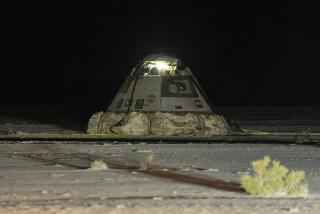Shuttle Schedule in Jeopardy After Edwards Landing
- Share via
EDWARDS AIR FORCE BASE — The luckless crew of the space shuttle Columbia glided in for a perfect predawn landing here Saturday, ending a frustrating mission and forcing the space agency to tiptoe along a tightrope for the next few months.
A slip in the schedule of more than a few days would kill one or more of the most important scientific missions planned during the shuttle era, including a space-borne observation of Halley’s comet.
Rainy weather in Florida forced the landing here, one that will cost the National Aeronautics and Space Administration six days of precious time because the spacecraft must be loaded atop a transport plane and flown back to the Kennedy Space Center in Florida.
Even if the hardware and the work crews cooperate, it will take extraordinary luck from the weather for NASA to do all it plans to do during the months ahead.
Some scientists who have worked for years to prepare the scientific missions are bitter that NASA allowed its schedule to become so crowded that the missions may have to be sacrificed.
The shuttle--a glider without running lights--touched down on the dry lake bed here at 5:59 a.m. It was visible only moments before it plunged into the brilliant beams from six runway lights, each putting out 800 million candlepower of illumination.
“We’re glad to see them back,” shuttle chief Jesse Moore said during a post-landing press conference from the Kennedy Space Center.
Will Shorten Processing
Robert Sieck, director of shuttle operations at the Florida spaceport, said five days would be shaved from the normal “46-day processing flow” required to get the shuttle ready for its next scheduled launch on March 6.
The launch date is critical because the Columbia is to carry a huge telescopic observatory in its cargo bay so that scientists can study Halley’s comet from afar at the same time that five international spacecraft collect data as they speed past the comet.
A slip of three or four days would mean Columbia would not be on station for most of the encounter, and a slip of five or six days would also jeopardize important scientific missions in May.
None of those problems should affect the next launch, however, in which the space shuttle Challenger will carry schoolteacher Sharon Christa McAuliffe into space. That liftoff is set for Jan. 25 and is not in any danger, Moore said.
He said he thought the space agency has “a very good shot” at making the March 6 launching of Columbia, which is to carry an ultraviolet observatory called Astro.
Scientist’s Criticism
One top-level scientist at the Goddard Space Flight Center in Greenbelt, Md., home of Astro, told The Times that NASA could have avoided the scheduling crisis earlier this month by scrubbing the Columbia flight that has just ended. Its launching was aborted six times--more than any other in the history of the shuttle program--putting a three-week crimp in the schedule.
The scientist was infuriated because, he said, the just-completed mission did not rank nearly as high in scientific importance as the March 6 mission.
“No one is willing to cancel it,” he said before the launching, “because no one at NASA headquarters is willing to bite the bullet.”
The flight carried Rep. Bill Nelson (D-Fla.), chairman of the House subcommittee that oversees NASA’s activities. It also deployed a communications satellite owned by RCA Corp., which paid NASA more than $14 million for the launch.
When asked why he did not cancel the flight earlier this month to protect the scientific mission in March, Moore said:
“I had a very important customer on this flight (RCA). Cancellation of this flight never crossed my mind.”
Delays Could Be Costly
Any future schedule delay could prove costly in the weeks ahead, however.
Sieck, the Kennedy shuttle director, said that if the March 6 launch is delayed “until the 10th or the 11th, it could affect Ulysses.”
Ulysses is a European spacecraft that is to be launched from the shuttle in early May to give scientists their first look at the polar regions of the sun. The craft is to use Jupiter’s gravity to fling itself out of the plane of the Earth’s orbit and over the sun’s poles.
Many NASA officials are extremely protective of that mission because it is all that is left of what was to have been a joint project in which both NASA and the Europeans would send separate spacecraft to study the opposite poles of the sun simultaneously. NASA canceled its space probe to Jupiter, however, because of other priorities, leaving the European craft the sole survivor of the ambitious plan.
If that launch date is delayed more than a few days the entire mission must be put off for 13 months because Jupiter will not be in the right position again until then.
Galileo Mission Schedule
A similar problem confronts another mission scheduled just five days after the Ulysses flight ends. On May 21, the Galileo spacecraft is to be launched from the shuttle for a mission to Jupiter. That mission would also have to be delayed 13 months if the launch date slips more than a few days.
Although NASA now has four working shuttles, it is not possible to simply switch payloads back and forth when scheduling problems arise because all the vehicles are obligated for specific missions, and it could take weeks to shift a payload from one shuttle to another.
“We knew 1986 was going to be a challenge,” Sieck said. “Landing at Edwards will increase the degree of difficulty.”
More to Read
Sign up for Essential California
The most important California stories and recommendations in your inbox every morning.
You may occasionally receive promotional content from the Los Angeles Times.













